Index

Review: High end battle indecisive
Nvidia launched its new dual GPU, Fermi-based GTX 590 card on March 24 and our today’s guest is Gainward Geforce GTX 590 3072MB GDDR5. The new GTX 590 combines two GF110 on one PCB. As you can see, Gainward used Nvidia’s reference cooler.
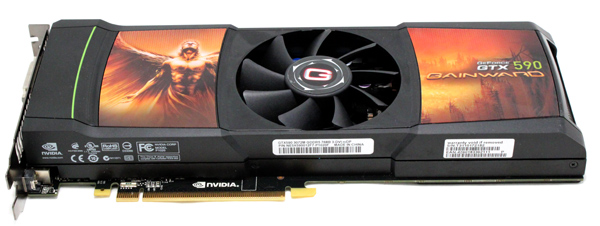
GF110 is currently Nvidia’s fastest GPU – the same one used on the single GPU GTX 580. GPU specs remain unchanged for the dual-GPU card, but clocks have been lowered in order to improve thermals.
While GTX 580’s GPU runs at 772MHz, GTX 590’s runs at only 608MHz. The specs below apply to our today’s sample as well.
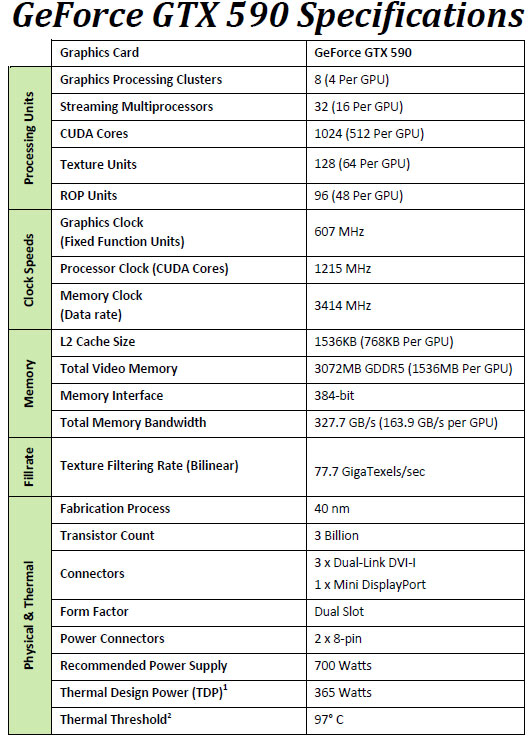
GTX 590 is a beast with 6 billion transistor and more than 2200 components on the card. Each core packs 512 CUDA processors, meaning that the card has a total of 1024. GTX 590 has eight GPCs (Graphics Processing Clusters), 32 streaming multiprocessors, 128 texture units and 96 ROPs. The memory interface is 384-bit and the 3072MB of memory is shared by two GPUs meaning the games can use only 1536MB of memory.
Nvidia used a single-PCB design with a central fan. As we already said, all Nvidia partners currently use reference cooling on GTX 590 cards and Gainward is no exception.
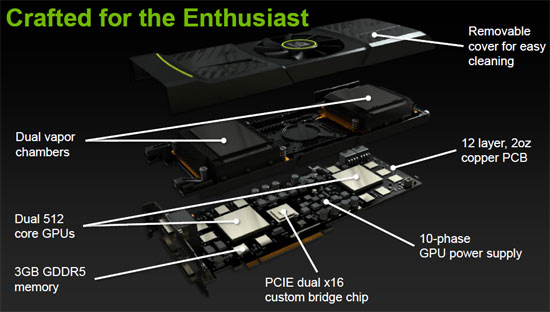
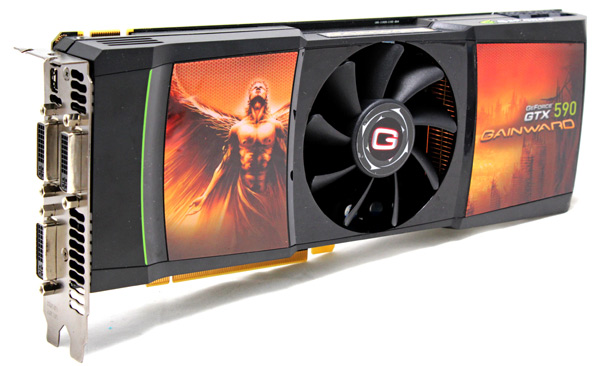
Gainward chose a pretty nice sticker and, as you can see, PCB is the reference one with four video outs. The center of the cooler is slightly lower than the far ends of the cooler, improving airflow in both directions.
Gainward GTX 590's cooler is not too loud during gaming, which surprised us. Nvidia obviously made sure that this is their quietest dual GPU card so far.
GTX 590’s thermal efficiency comes from using two vapor-chambers and their heatsinks. The outlets on the front and back of the card are there to push hot air out, helping the fan to run without making much noise. Bad thing about such a design is that temperatures inside the case can go up significantly, which means that you should make sure of optimum air flow inside your case.
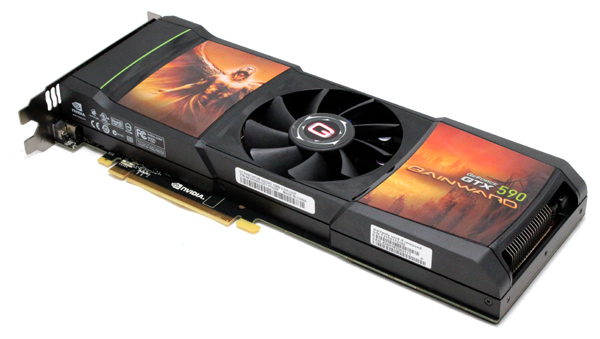
The back of the GTX 590 has two passive heatspreaders that serve as backplate for vapor chambers as well. Below the black plates you’ll find GDDR5 memory modules, so the memory has passive cooling. The memory in question comes from Samsung - K4G10325FE-HC04 specified to run at 1250MHz (5000MHz effectively).
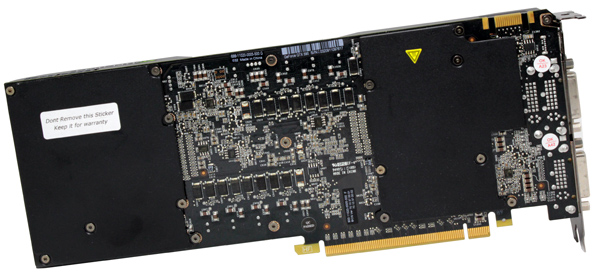
GTX 590 is almost 11 inches long whereas the HD 6990 is about 12.2 inch. You can check out the comparison between these two cards below.
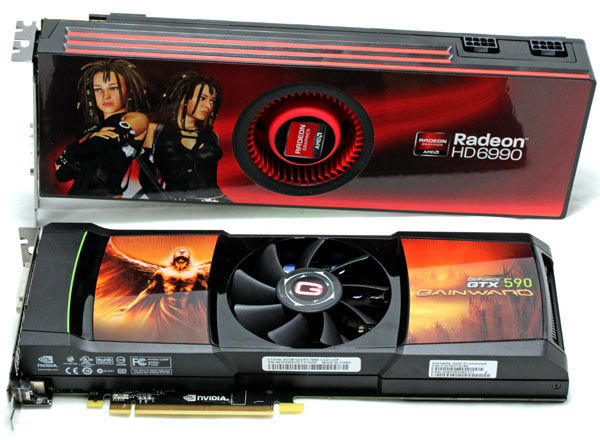
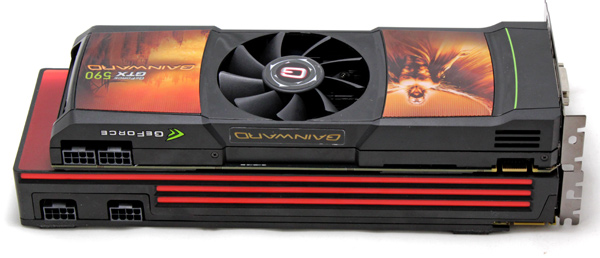
Powering the fastest high-end cards today requires two 8-pin power connectors. GTX 590 has a 365W TDP and Nvidia recommends an 800W PSU. GeForce logo above the power connector glows when the card is running. In case the card has power trouble, it will blink.
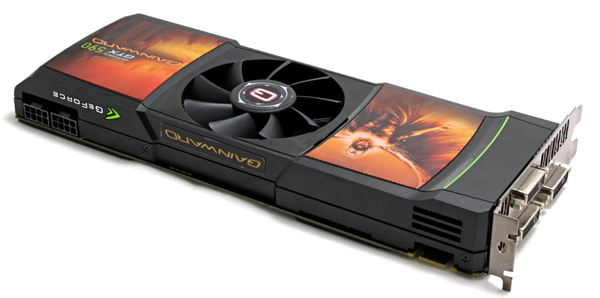
Geforce GTX 590 has one SLI connector, which is enough for Quad SLI. Of course, Quad SLI will require at least a 1100W PSU as well as a motherboard that will allow at least one extra slot between the two cards.
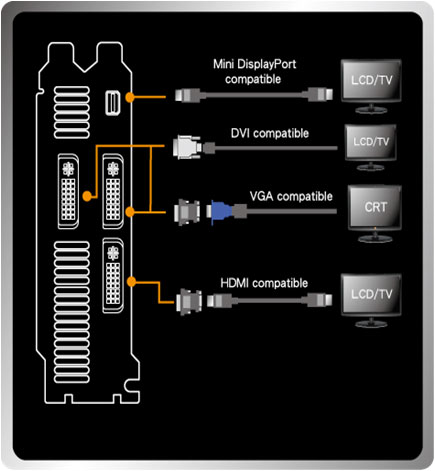
Gainward’s GTX 590 allows you to indulge in some Nvidia Surround. The card comes with four video outs and, since it is a dual GPU card, you can simultaneously use up to four displays. Fermi cards usually allow for only two displays due to Nvidia’s single-GPU design limitations. As you can see from the picture, GTX 590 comes with three dual-link DVIs and one mini-DisplayPort.
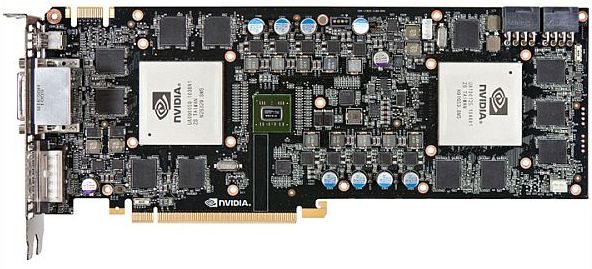
The PCB holds two GF110 as well as one Nvidia NF200 PCI-Express bridge chip, which enables for internal communication via x16 PCI-E lane connection. The NF200 is manufactured on an 80nm process and consumes about 12W. The GPU uses 10 phase regulation whereas the memory uses 4-phase. Nvidia opted on CHiL CHL8266 voltage regulator, one per each GPU (the same regulator is used on GTX 580 / GTX 570 cards).
Vapor chamber technology needs no classic heatpipes for transferring heat from the cooler base to the heatsink. The vapor chamber, which is the cooler’s base at the same time, is in charge of trasfering GPU heat to the heatsink. That way, air can flow through the heatsink unobstructed, which is not the case when using heatpipes that obstruct airflow.
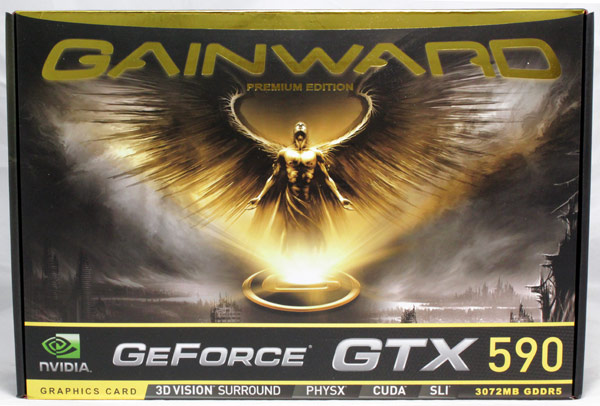




Motherboard: EVGA 4xSLI
CPU: Core i7 965 XE (Intel EIST and Vdrop enabled)
Memory: 6GB Corsair Dominator 12800 7-7-7-24
Harddisk: OCZ Vertex 2 100 GB
Power Supply: CoolerMaster Silent Pro Gold 800W
Case: CoolerMaster HAF X
Fan Controler: Kaze Master Pro 5.25"
Operating System: Win7 64-bit
Nvidia 270.51_desktop_win7_winvista_64bit
AMD 11.4 Preview CCC


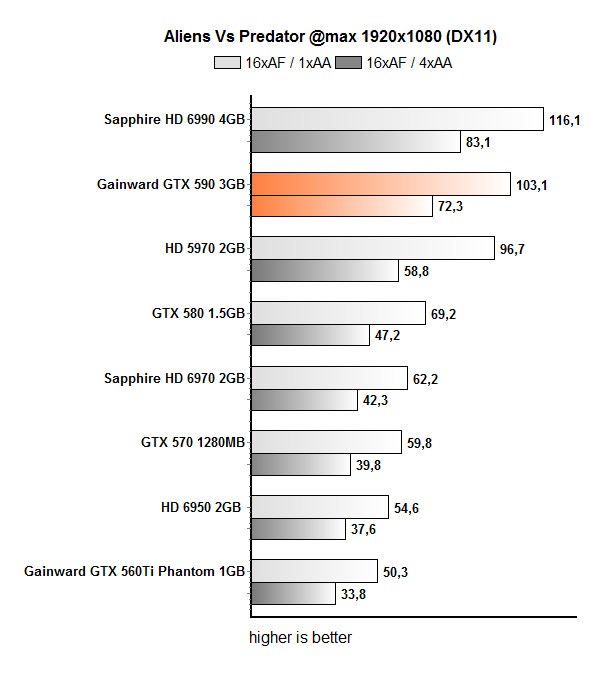
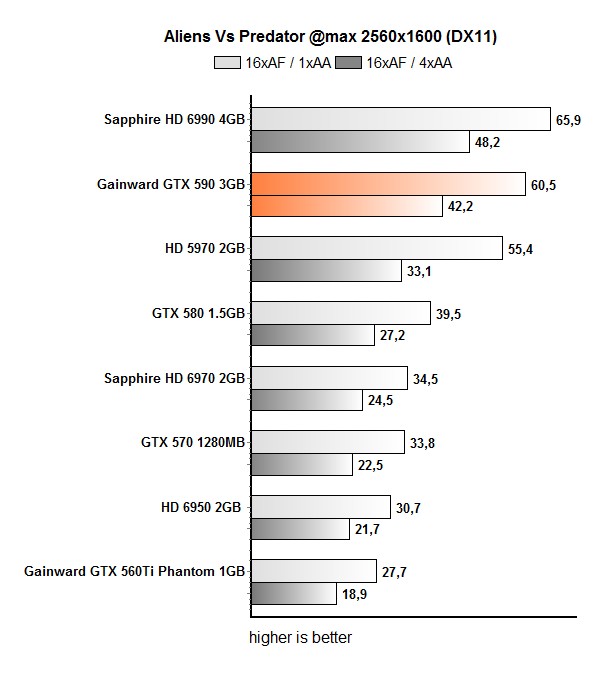


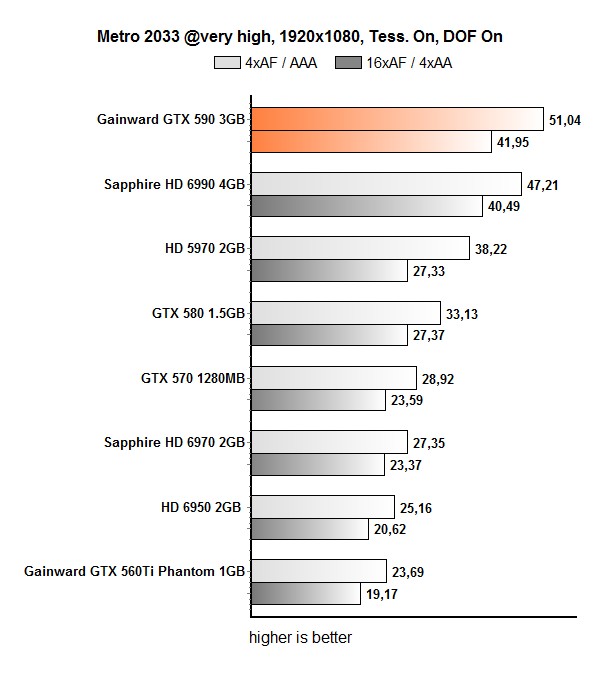
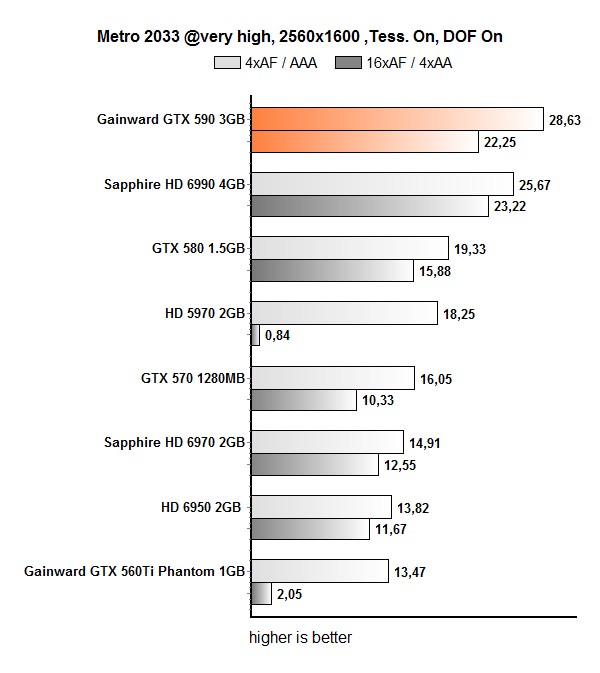


Overclocking
We overclocked Gainward’s card without increasing voltages. You can see the results on the following GPUZ screenshot. We pushed the GPU to 720MHz, which seems to be the limit for air-cooler GTX 590 cards.
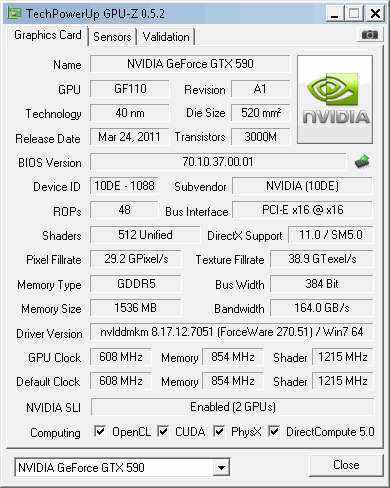
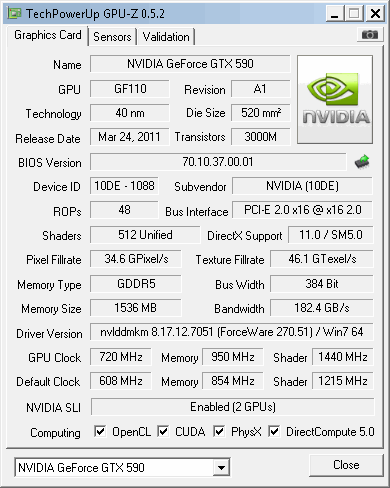
Although we played Aliens vs Predator with no trouble at 720MHz GPU clock, we could not complete 3DMark 2011 at GPU clock higher than 680MHz.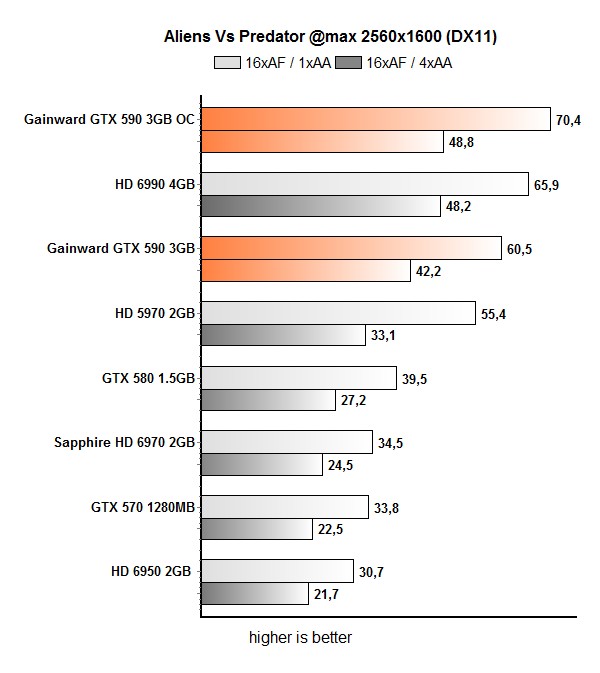
Noise and Thermals
Compared to HD 6900, GTX 590 is also slightly quieter. GF110’s temperatures can hit up to 88°C during gaming, so there’s not much headroom for compensating loudness by sacrificing thermals (our measurements were made with room temperature at about 25°C).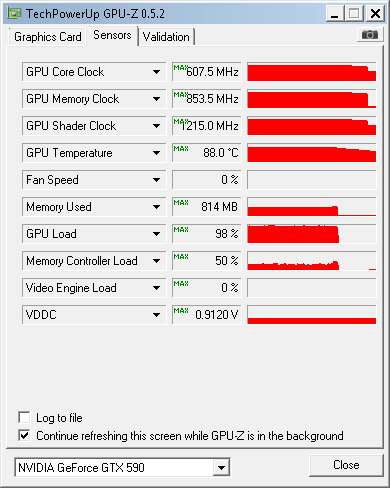
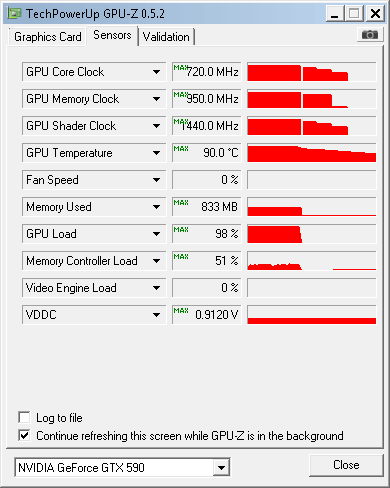
Power Consumption
Gainward’s GTX 590 is not for those who like them cheap power bills, as only a slightly meaner rig with a GTX 590 inside can easily draw 600W. Compared to HD 6990, Nvidia’s offering consumes about 60W more under load and about 10W more when idle.
Our today’s guest was Gainward’s GTX 590 3072MB GDDR5 768B 3-DVI mDP dual-GPU card. We’re talking about a card based on Nvidia’s reference design and you can find it available at €600, here.
Cooling the GF110 is a task for the dual-slot cooler with a central fan which, with a little help from vapor chamber tech, does a pretty good job. The fan’s noise levels are acceptable when the card is running 3D. The same GF110 is used on GTX 580 cards, but GTX 590’s clocks are lower. This unfortunately means that you’ll get more performance with two GTX 580 cards.
We’d be wrong if said that Nvidia’s GTX 590 is faster than AMD’s HD 6990 because depending on tests, one car may have certain advantages. AMD claims their offering is the fastest one around, and Nvidia pretty much does the same. One thing is for certain though – both cards provide a really mean punch and are any gamer’s dream. The fight between these two cards may very well depend on price drops of these dual-GPU cards, which will ultimately benefit both sales and users. Since it is a dual-GPU card, Gainward’s GTX 590 will allow for using four displays.
AMD’s HD 6990 currently goes for less but if you prefer Nvidia – then you really can’t go wrong with Gainward’s GTX 590, which by the way is the most affordable GTX 590 card around.



